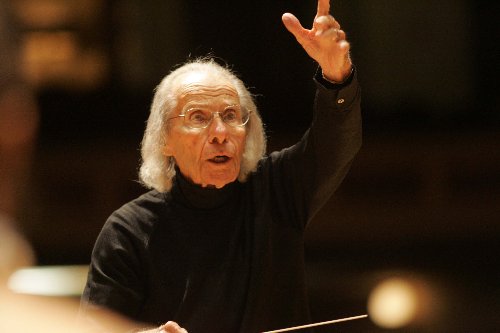

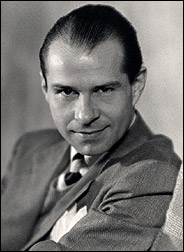 FF: A wind band
is a wide open category. When you say "symphony orchestra," because
there are so many very well-known, long-famous performing ensembles
— like the Chicago Symphony Orchestra — I don’t think anybody
has to have a picture painted for them of what that is. That’s because
it has had a consistent history for close to four hundred years of gradual
evolution to what it is today. The sit-down wind band doesn’t have
that, so we don’t have an immediate focus or idea of what this is.
FF: A wind band
is a wide open category. When you say "symphony orchestra," because
there are so many very well-known, long-famous performing ensembles
— like the Chicago Symphony Orchestra — I don’t think anybody
has to have a picture painted for them of what that is. That’s because
it has had a consistent history for close to four hundred years of gradual
evolution to what it is today. The sit-down wind band doesn’t have
that, so we don’t have an immediate focus or idea of what this is.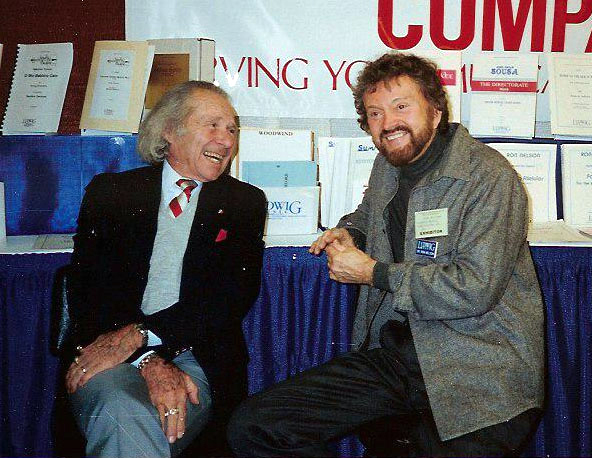 BD: And this is
enough of an inducement to get them to write?
BD: And this is
enough of an inducement to get them to write?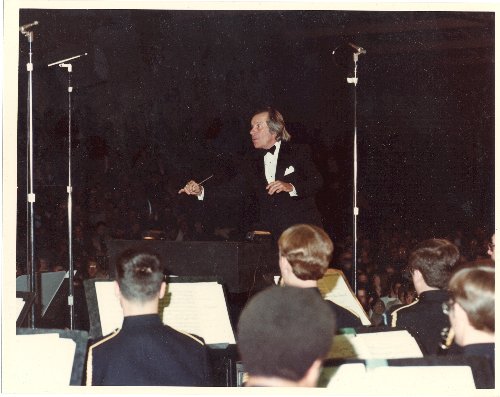 FF: Yes, I think we are free. I do believe,
at the same time, that we do have a basic literature which is very small and
distinguished in its way. But it’s very, very thin, in comparison to
the masterpieces, or the joyful pieces of almost any other branch of the
creators’ art in music. We need literature desperately. The school
band, the university band, they’re green-eyed monsters! They just chew
up material as fast as they can get it! Frequently a student goes to
a very good high school, and by the time he’s gotten to a Northwestern University,
he’s played ninety percent of this basic literature! And at Northwestern,
he’s going to get it again. If he goes somewhere else, he’s going to
get some small piece of it, but at Northwestern he’d certainly get a solid
dose of the new pieces, also. They all must spin off of something that
is basic, and we do have some things that are basic, but we need more and
more and more every day! We need the most enormous creative outpouring
that anybody can imagine! I don’t know whether we’re going to get it
or not, but we really need it. I think that the enterprise and the
work and the skill of any number of men from the beginning of the twentieth
century up to now, who have given so much to it are to be thanked.
I think the players deserve everything they can get from a composer.
FF: Yes, I think we are free. I do believe,
at the same time, that we do have a basic literature which is very small and
distinguished in its way. But it’s very, very thin, in comparison to
the masterpieces, or the joyful pieces of almost any other branch of the
creators’ art in music. We need literature desperately. The school
band, the university band, they’re green-eyed monsters! They just chew
up material as fast as they can get it! Frequently a student goes to
a very good high school, and by the time he’s gotten to a Northwestern University,
he’s played ninety percent of this basic literature! And at Northwestern,
he’s going to get it again. If he goes somewhere else, he’s going to
get some small piece of it, but at Northwestern he’d certainly get a solid
dose of the new pieces, also. They all must spin off of something that
is basic, and we do have some things that are basic, but we need more and
more and more every day! We need the most enormous creative outpouring
that anybody can imagine! I don’t know whether we’re going to get it
or not, but we really need it. I think that the enterprise and the
work and the skill of any number of men from the beginning of the twentieth
century up to now, who have given so much to it are to be thanked.
I think the players deserve everything they can get from a composer.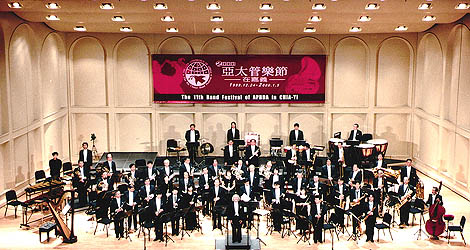 BD: These are all
by Japanese composers?
BD: These are all
by Japanese composers?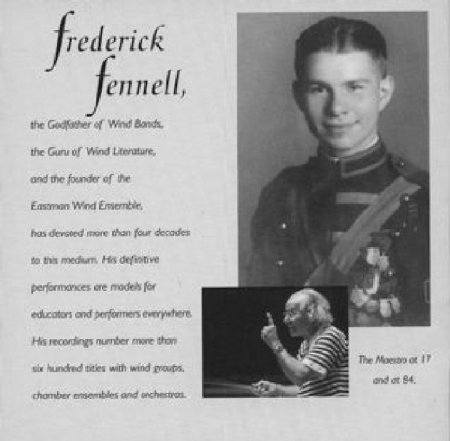 BD: So the technical
ability has gotten better over the years. Has the musicianship also
gotten better over the years?
BD: So the technical
ability has gotten better over the years. Has the musicianship also
gotten better over the years?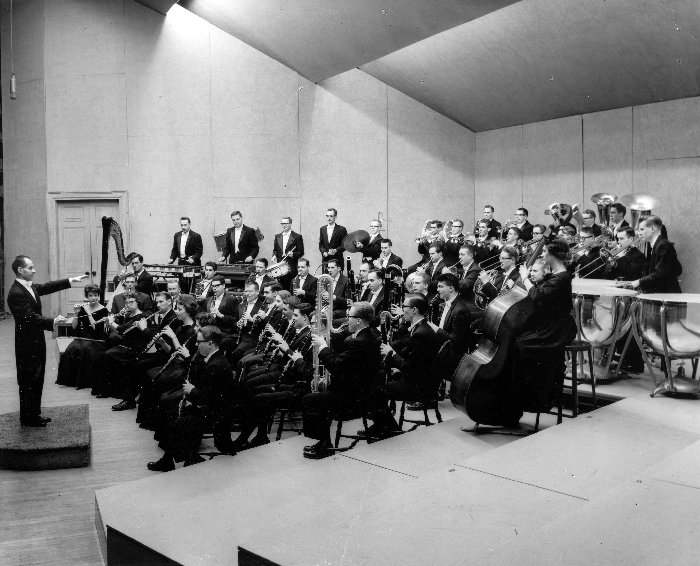 FF: Very exciting.
The Eastman time was the fruition of many years of thought. And we
were able to do what I don’t think anybody ever thought that the Eastman
School of Music would do, because we were known to the profession as an orchestral
school. And of course, it’s a music school; it’s an all-kinds-of-muisc
school. The wind ensemble was such a simple idea whose time had come,
and there was this repertory there that nobody had recorded. My own
background, love and belief in a wide range of music opened up the whole
door to recording an album of marches the way, frankly, nobody else had ever
recorded them. They were recorded like they were the Beethoven Fifth Symphony. We put that kind
of energy into rehearsing them and I put that kind of energy into making
sure what was down on the page was just the way it should be. It had
an interpretive characteristic of my own and of the players that was different.
That’s the way I always thought marches should be played! As a matter
of fact, regarding the marches we recorded with the Eastman Wind Ensemble,
I worked those out marching my way through high school. I always said,
“Someday, when I have my own group, this is how we’re going to play the National Emblem.” And that’s how
we’d play National Emblem.
It wasn’t something I started to work at when they said, “How would you like
to make a record?”.
FF: Very exciting.
The Eastman time was the fruition of many years of thought. And we
were able to do what I don’t think anybody ever thought that the Eastman
School of Music would do, because we were known to the profession as an orchestral
school. And of course, it’s a music school; it’s an all-kinds-of-muisc
school. The wind ensemble was such a simple idea whose time had come,
and there was this repertory there that nobody had recorded. My own
background, love and belief in a wide range of music opened up the whole
door to recording an album of marches the way, frankly, nobody else had ever
recorded them. They were recorded like they were the Beethoven Fifth Symphony. We put that kind
of energy into rehearsing them and I put that kind of energy into making
sure what was down on the page was just the way it should be. It had
an interpretive characteristic of my own and of the players that was different.
That’s the way I always thought marches should be played! As a matter
of fact, regarding the marches we recorded with the Eastman Wind Ensemble,
I worked those out marching my way through high school. I always said,
“Someday, when I have my own group, this is how we’re going to play the National Emblem.” And that’s how
we’d play National Emblem.
It wasn’t something I started to work at when they said, “How would you like
to make a record?”.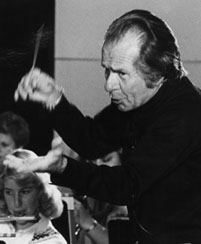 FF: Anything.
Never say no. Conduct anything you can get your hands on! You’re
bound to learn something from it if you want to. Then start working
your way to the way you want to go. But most of all, do anything you
can in any kind of pit — any kind of Broadway show,
any kind of bawdy show, any kind of anything in the pit. Get in that
pit! That’s where it is! Then after that, be lucky enough to
convince eight or ten other people to sit down and make music with you.
If you do that, you’ve got it made. I believe firmly that people let
you conduct. The world lets you be a conductor, or not, and there isn’t
very much you can do about it! If somebody likes what you do, they’ll
maybe ask you to do it again — maybe. No guarantees. No guarantees!
The only guarantees are people who have certain jobs at schools that seem
to go on and on, and I hope they will always try to be more up and up with
it, instead of just on and on with it. But nothing is guaranteed.
There is no tenure in the music business, not really! No guarantees
of employment. And people literally let you conduct! And when
I say people, that means lots of people — managers,
stage managers, concert managers, boards of directors.
FF: Anything.
Never say no. Conduct anything you can get your hands on! You’re
bound to learn something from it if you want to. Then start working
your way to the way you want to go. But most of all, do anything you
can in any kind of pit — any kind of Broadway show,
any kind of bawdy show, any kind of anything in the pit. Get in that
pit! That’s where it is! Then after that, be lucky enough to
convince eight or ten other people to sit down and make music with you.
If you do that, you’ve got it made. I believe firmly that people let
you conduct. The world lets you be a conductor, or not, and there isn’t
very much you can do about it! If somebody likes what you do, they’ll
maybe ask you to do it again — maybe. No guarantees. No guarantees!
The only guarantees are people who have certain jobs at schools that seem
to go on and on, and I hope they will always try to be more up and up with
it, instead of just on and on with it. But nothing is guaranteed.
There is no tenure in the music business, not really! No guarantees
of employment. And people literally let you conduct! And when
I say people, that means lots of people — managers,
stage managers, concert managers, boards of directors.|
Frederick Fennell (1914-2004) began his career as a conductor almost as soon as he arrived at the University of Rochester’s Eastman School of Music in the fall of 1933 when, to his amazement, he discovered that no wind band of any kind existed at either campus. He then devoted a considerable portion of the next 30 years of his life to the amicable amelioration of this condition, organizing and conducting outdoor and indoor groups, which led him to establish the Eastman Wind Ensemble in 1952. He conducted the group for its first decade, and spread wide its simple message through the Eastman/Mercury Records American music recording project at the invitation of composer and Eastman Director Howard Hanson. The Wind Ensemble’s original 23 LPs, now in crossover to CDs, caused reconsideration of the wind medium as a serious artistic pursuit. Dr. Fennell later joined the Minneapolis Symphony as associate music director, and then moved to the University of Miami as conductor in residence. He was principal guest conductor of the Interlochen Arts Academy, and other guest conducting appearances include the Boston Pops Orchestra as well as performances with the Carnegie Hall Pops Concerts and the Boston Esplanade concerts. He also conducted the Denver, San Diego, National, Hartford, St. Louis and London Symphonies; the Buffalo, Calgary and Greater Miami Philharmonic Orchestras, the Cleveland Orchestra and the New Orleans Philharmonic. In 1984, at the invitation of its players he became the initial principal conductor of the Tokyo Kosei Wind Orchestra of Japan and later, conductor laureate. Dr. Fennell was also part of pioneering recordings with the Cleveland Symphonic Winds and Dallas Wind Symphony. A legion of additional honors include an honorary doctorate from the University of Rochester; the Honor Medal of Interlochen, the Midwest Clinic, and the John Philip Sousa Society; a concert hall built in his name in Kofu, Japan; and the 1994 Theodore Thomas Award of the Conductor’s Guild. The 1993 Roger Rickson bio-discography, Fortissimo, (Ludwig Music, Inc., publisher) covers in a fat format the past 40 years of the Fennell story as well as Robert Simon’s new book, Fennell: A Tribute to Frederick Fennell, which includes the following quote: For over seven decades, Frederick Fennell has been America's Ambassador of music around the world. I have loved his editions and recordings since I first played them in high school. It was an honor to have him conduct the Marine Band as President and I congratulate him on this richly deserved lifetime achievement tribute and award. |
This interview was recorded in Chicago on December 16, 1987.
Portions were used on WNIB (along
with musical examples) on eight different broadcasts during the years 1989-99.
The transcription was made in 2008 and posted on this website in November
of that year.
To see a full list (with links) of interviews which have been transcribed and posted on this website, click here.
Award - winning broadcaster Bruce Duffie was with WNIB, Classical 97 in Chicago from 1975 until its final moment as a classical station in February of 2001. His interviews have also appeared in various magazines and journals since 1980, and he now continues his broadcast series on WNUR-FM, as well as on Contemporary Classical Internet Radio.
You are invited to visit his website for more information about his work, including selected transcripts of other interviews, plus a full list of his guests. He would also like to call your attention to the photos and information about his grandfather, who was a pioneer in the automotive field more than a century ago. You may also send him E-Mail with comments, questions and suggestions.